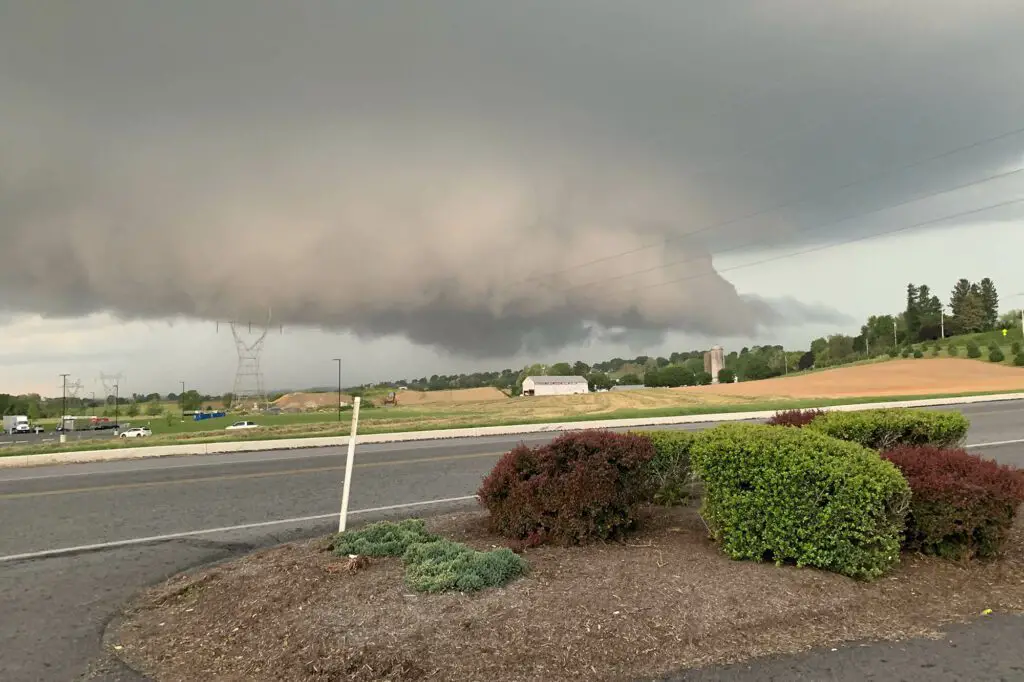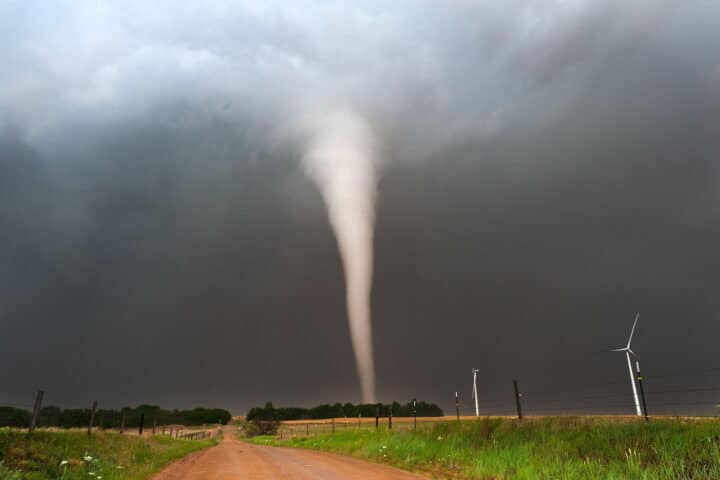Most common in the U.S. in the Great Plains and the Southeast, tornadoes are one of nature’s most violent weather events. Since thunderstorms always precede tornadoes, thunderstorms are prevalent in the same regions as tornadoes.
The National Weather Service issues a tornado watch when severe thunderstorms capable of producing tornadoes are possible in an area. Keep reading to learn more about tornadoes, tornado warnings, and some tornado safety tips.
How Does a Tornado Form?
Tornadoes typically form within thunderstorms, specifically supercell thunderstorms with deep rotating updrafts. Tornadoes can generate wind speeds of over 100 mph and over 200 mph in the strongest tornadoes.
In a supercell thunderstorm, a robust vertical wind produces a horizontally rotating cylinder of air lifted by the updraft within the supercell. As the rotating cylinder of air narrows, the wind speed increases and the cylinder of air stretches to form a tornado.
Infographic
We’ve distilled the information above down to an easy-to-understand infographic for our subscribers. For performance reasons, a lower-quality image is shown on this page. To save the full-size image to your computer, click the “download” button below the infographic.
What is a Tornado Watch?
When conditions are favorable for severe thunderstorms and tornadoes in an area, the National Weather Service issues a tornado watch. The issuance of a tornado watch only hints at the possibility of a severe thunderstorm and tornado and does not necessarily mean one is likely in any one location.
Since severe thunderstorms are the precondition for tornadoes, a tornado watch is issued based on the likelihood that severe thunderstorms with the rotational component we previously discussed will occur.
According to the National Weather Service, a severe thunderstorm is characterized by:
- Hail with a one-inch diameter or greater
- Winds of 58 mph or higher
A severe thunderstorm watch would be issued if one of these weather conditions is likely to occur. But if the storms may rotate, the National Weather Service will issue a Tornado Watch instead.

What is a Tornado Warning?
Unlike a tornado watch, tornado warnings solely depend on the arrival of a tornado. The National Weather Service issues a tornado warning when a tornado is imminent.
After a tornado warning is issued, it is essential to prepare and find a place to seek shelter. Tornadoes vary in size and intensity, with some tornadoes only lasting seconds while others can last more than an hour. Most tornadoes last less than ten minutes, however.
The size of a tornado can be deceiving since there are significant tornadoes that cause minor damage and small tornadoes that do considerable damage. Although a large tornado may seem more intimidating, the size of a tornado does not correlate with the intensity of the tornado or its destructive potential.
Regardless of the lifespan or size of a tornado, you should always prioritize your safety and take preventive measures to prepare for a tornado to reduce the potential for injury. Keep reading to learn about some important tornado safety tips.
Tornado Safety Tips
The most effective way to increase survivability and reduce the risks for injury during tornadoes is preparation. Here are some tornado safety tips to help you prepare for a tornado:
- Find a place to seek shelter. The best defense between you and a tornado is physical barriers such as walls. Some homes in tornado-prone areas are constructed to withstand tornadoes and feature reinforced areas to protect occupants or an exterior tornado shelter, but most homes are not so tornado-proof. Basements, storm cellars, or other safe rooms are ideal places to wait for tornadoes to pass.
- Be aware of weather forecasts. Aside from protecting and distancing yourself from a tornado, staying up to date on weather forecasts is essential for dealing with tornadoes and other severe forms of weather. Use a weather radio or mobile device to stay informed about weather forecasts in your area.
- Store valuables and loose objects. If you want to preserve specific valuables in your home, transfer them to a safer location. Do this before the tornado arrives, and preferably well ahead of time. Always prioritize your safety first and only store away your belongings if a tornado watch is issued and you have time to prepare.
Taking steps to prepare for a tornado is critical for reducing the damage a tornado inflicts on you or your property. Since access to information is crucial during tornadoes, you can prepare for a tornado by using a weather radio.
The Midland WR300 is one of the best weather radios available. This weather radio not only provides you with standard SAME alerts but also non-weather alerts with its large, easy-to-read display.

Wrapping Up
Tornadoes are a severe form of weather, but there are steps you can take to prepare to ensure your safety. Weather radios can help you stay informed about tornadoes and other extreme weather events.
When facing a tornado, seek shelter and follow ongoing weather forecasts to stay informed.




